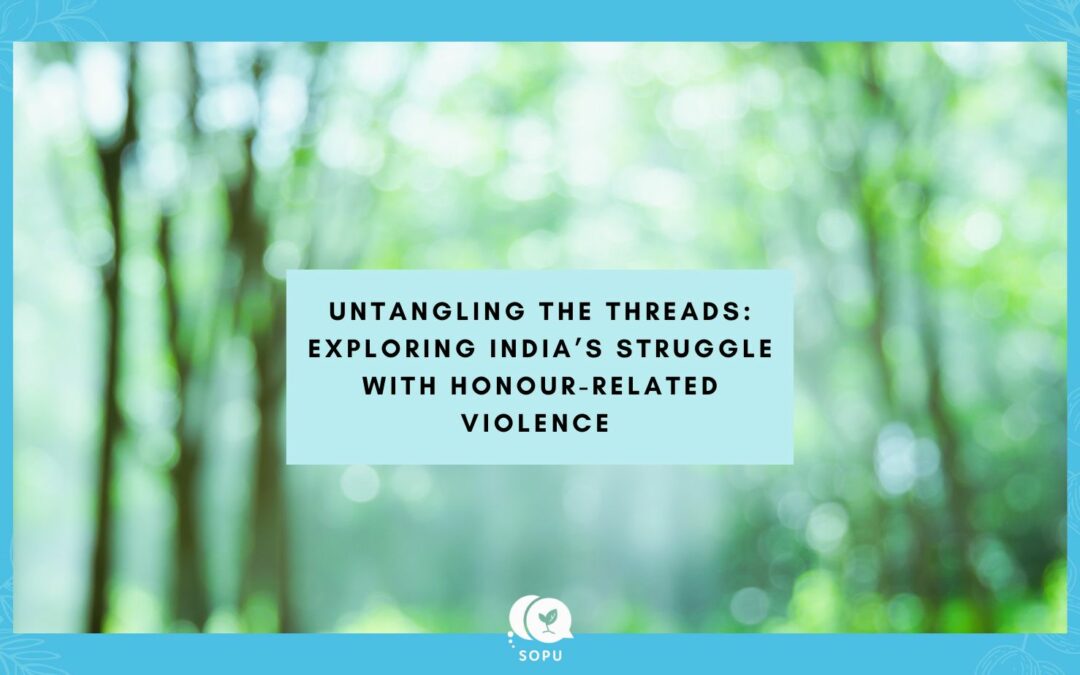Untangling the Threads: Exploring India’s struggle with honour-related violence
Tämän blogitekstin on kirjoittanut Sopu-työssä työharjoittelun tehnyt Debjani. This blog has been written by Sopu-work’s intern Debjani.
We can neither live without communities nor live entrapped within them.
Violence, including honour-related violence, can affect anyone, anywhere, and is not inherently tied to any specific culture or religion. The consequences of such violence and individual response to it vary due to numerous underlying factors. Concepts of honour, pride, and respect are deeply embedded in the values, norms, and ethics of every culture and civilization, whether eastern or western, caste-based, or religious. Different things in different contexts can trigger violence, i.e. concepts of honour (=perceptions of social and moral values and norms) can vary. The fact that a person is coming from a country with strong patriarchal norms does not inherently make someone a perpetrator of violence. The dynamics and circumstances within individual families often have a greater impact than the culture at the macro level. Terms such as ”immigrant culture,” ”immigrant community,” and ”honour culture” are overly simplistic. They try to describe a group or phenomenon that is far too broad to be defined in one word. Understanding these issues require an open mind and a willingness to challenge personal biases. A holistic approach is essential to dive into and understand the root causes of the problems.
Honour-related violence (HRV) remains a significant issue in many regions of India, deeply embedded in the country’s socio-economic structures and diverse traditions that vary by locality. It is increasingly recognized as a grave social issue that demands attention and action. Due to the country’s vast size, diverse population, & complex socio-cultural landscape, addressing it and working together to bring changes are immensely challenging. Various advocacy groups, NGOs, and grassroots organizations are working to raise awareness, challenge societal norms, and provide support to victims and survivors.
HRV in India is typically linked to rigid socio-economic hierarchies and patriarchal norms that govern family and societal honour, particularly concerning women. These crimes stem from the perceived necessity to uphold a group or community (family, clan, caste, gotra, neighbourhood, village, religion) honour, which is often associated with strict set of rigid & unwritten rules. In general, honour can be related to some societal norms that can be found in every society. It is just that the norms are different based on the countries and the specific traditions. It is based on certain customs or values. When this moral value crosses the boundaries of individual freedom, the identity becomes taboo. To maintain the values and not to lose them, one is expected to follow certain rules that constitutes the values of honour for a particular group. In India, ‘perceived’ honour continues to be existent within certain groups or communities where people feel empowered by the idea that others do not belong there. The concept is very complex due to its sensitivity and the variety of how it’s being understood in different families or groups or regions. The concept is depicted in various forms through Indian literature, movies, songs and folklores.
To understand the contemporary Indian society, it is essential to comprehend its history and the subsequent developments over thousands of years, including the impacts of colonialism. The predominant religion in the Indian subcontinent has been Hinduism, a philosophy and a way of life that emphasizes pluralism and divine spirituality. At its core, Hinduism believes in the inherent equality of all beings. This philosophy fosters a natural coexistence of various religions, as it acknowledges that every individual connects with the Divine in own unique way. There is no single path to the Divine, as each person is different, and so are the methods of worship. This belief in multiple deities in various forms reflects the goal of finding one’s inner soul and connecting with the Divine through various ways. This very concept of pluralism facilitated the co-existence of multiple religions side-by-side over the years. Indian culture, while predominantly influenced by Hinduism, has also been shaped by many other religions and traditions. It portrays a ’feminine’ ideal of modesty and shame, akin to other South Asian cultures in many respects. It is a nation of immense diversity, encompassing a wide array of religions, cultures, languages, food, traditions, and dress patterns, each uniquely contributing to the collective identity of being Indian. The essence of being Indian lies in its multiculturalism and diversity, encapsulated by the phrase ”unity in diversity,” a characteristic unparalleled by any other country in the world. Defining India by any single community, clan, or culture is nearly impossible due to its vast and magnanimous diversity.
Despite India’s inclusive philosophical foundations, which historically saw women writing scriptures and participating in various social activities, Indian society has undergone a significant socio-economic change that have influenced gender roles and societal norms. The current caste system in India is not rooted in religion. The word ‘caste’ comes from the Portuguese word ‘casta’ (class, race, lineage). Traditionally, India had a system known as “Varnashrama,” comprising of four parallel streams based on occupation. The arrival of the various invaders reshaped India’s socio-economic structure leading to many changes in the system. People began to recognize how the system could be manipulated to gain power over others, initiating the transformation towards the contemporary caste system. Brahmins, who held intellectual authority, began to exploit their position to assert superiority, and other castes also utilized the system for power. Along with other factors, this shift also contributed to the marginalization of women, and exertion of violence to control & preserve “perceived” honour concepts. With the British taking power in India, they further exploited the caste system as a tool of social control, reinstating privileges that had been previously repealed by other rulers. Despite legal prohibitions, the caste system continues to significantly influence social interactions and relationships in India.
Inter-caste & inter-religious marriages, and women not following certain societal norms and values of a community or family are amongst the primary triggers for honour-related violence in India. In many cases, families, or communities resort to extreme measures to prevent or punish relationships that cross boundaries due to fears of social ostracization and loss of status within their communities. HRV is more prevalent in certain states, especially in northern and some parts of southern India. This prevalence can be attributed to the strong influence of traditional customs and the power of local governing bodies such as the ”khap panchayats.” They are traditional village councils with substantial influence in rural areas with no legal status. Traditionally, they were involved in resolving local disputes and maintaining social order. Khap Panchayats typically consist of male elders from the same clan or community who exercise authority based on tradition and practices. All ‘khap’ members are ostensibly connected by blood and a common genealogy, leading to many marital taboos and bans on same-village or same-gotra marriages, inter-caste or inter-religious marriages. They make decisions based on their interpretation of social norms and customs, often reflecting patriarchal values and hierarchical structures. These patriarchal groups reject the role of the state and law in preventing honour killings, viewing it as unacceptable interference in their socio-cultural values and family structures. These councils often uphold rigid values and issue decrees that perpetuate HRV, placing family or community honour above individual rights and freedoms, particularly for women. In many cases, upholding such honour leads to the brutal killing of individuals or couples who defy societal norms. Even when families might agree to a relationship outside the community’s unwritten rules, they are often compelled by community pressure to treat it as a matter of honour. If they do not, community leaders may take over the proceedings. Thus, families may end up sacrificing their children for the collective interest of the community.
Some honour-related violence persists in modern and urban settings as well. Families, regardless of their economic status or formal education level, may resort to extreme violence to control the actions of their family members or loved ones. The pressure to conform to societal norms continue to drive such behaviours, illustrating that HRV can also transcend socio-economic boundaries. Interestingly, there is a contrast in some of these acts of violence committed by family members against their children. While they perpetrate these crimes, they often try to conceal them from other family members or neighbours. They are aware that their actions are wrong, and they could face ostracization or legal charges if caught. Modern society generally does not accept these acts of violence, and many people remain ignorant of these criminal activities.
Addressing the complex issue of honour-related violence (HRV) in India necessitates a multifaceted approach that includes legal reforms, understanding human psychology, raising awareness at all levels, promoting education that fosters open-mindedness, challenging personal biases, and engaging continuously with communities. There has been a growing recognition amongst policymakers, activists that HRV is not just a private matter but a violation of human rights. This shift in perspective has led to increased dialogue and interventions aimed at preventing and addressing HRV in all its forms. Individuals with privileges need to break the culture of ignorance and silence surrounding this issue, both living in India and abroad. Through leading by example and raising awareness, each one of us can help to work towards eradication of such rigid mindsets and traditions.
In any society worldwide, formal education does not necessarily equate to an education that fosters open-mindedness and awareness. By embracing and acknowledging diverse perspectives, we can gain deeper understanding on a complex issue like HRV. Integrating insights from sociology (influence of structures, class differences), gender studies (gender norms, power dynamics, hierarchies, intersectionality), social psychology (role of shame for acceptance, belonging to a group, survival techniques, moral and social values, norms, status), psychology (condition of self-esteem due to the impact of shame, importance of attachments, fear, love, trauma), country specific politics & global politics impact (political upheavals and trends, colonialism, poverty, inequality, racism, discrimination, minority status), history of violence, intergenerational traumatic experiences and behaviours etc. can open the factors in front of us to grasp the humongous nature of HRV. All these factors are vital to address the complicated issue of HRV not just in India, but in general. With this understanding, we can work towards fostering a society where respect for individual rights, freedom, and dignity supersedes outdated notions of perceived honour and hierarchy that can pave the way for meaningful change.
References:
- https://triumphias.com/blog/the-concept-of-gotra/
- https://www.sanskritimagazine.com/genetics-behind-hindu-gotra-system/
- https://unacademy.com/content/railway-exam/study-material/history/european-colonialism-in-india/
- https://citeseerx.ist.psu.edu/document?repid=rep1&type=pdf&doi=7302054d5d4a0c7c438a4a242b65c05f748d35ac
&

